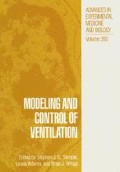Abstract
Thoracoabdominal movements (TAM) represent two parallel pathways for the distribution of body wall volume displacements. Thoracic and abdominal pathways provide two “degrees of freedom” by which body wall movements accommodate lung volume changes (12). During spontaneous breathing in normal humans, inspiration is the “active phase” of respiration, and expiration is normally passive. Respiratory movements of the thorax and abdominal wall are both driven by the actions of the diaphragm, as well as by muscles intrinsic to each structure. To a useful approximation, abdominal movements reflect directly the movements of the diaphragm in quiet breathing. Thoracic movements may be passive (caused by the action of the diaphragm, using the abdominal contents as a fulcrum to lift the lower rib cage) or active (caused by action of the intercostal and thoracic “accessory” inspiratory and expiratory muscles). During normal quiet breathing, thoracic and abdominal movements are in large part, passive, closely synchronized (in phase), reflecting primarily the action of the diaphragm driving both structures (8). It may be said that TAM during resting breathing are relatively unitary: not only are thoracic and abdominal movements in phase, but their relative amplitudes are nearly constant. This constitutes TAM manifesting only one “degree of freedom,” (despite the potential for utilizing two degrees of freedom).
Access this chapter
Tax calculation will be finalised at checkout
Purchases are for personal use only
Preview
Unable to display preview. Download preview PDF.
References
Agostoni E & Mognoni P. (1966). Deformation of the chest wall during breathing efforts. J. Appl Physiol 21:1827–32.
Ashutosh K, Gilbert R, Auchincloss JH & Peppi D. (1975) Asynchronous breathing movements in patients with chronic obstructive pulmonary disease. Chest, 67, 553–7.
Campbell, EJM & Green JH. (1955). The behaviour of the abdominal muscles and the intra-abdominal pressure during quiet breathing and increased pulmonary ventilation: a study in man. J. Physiol, London 127:423–26.
Coumand A, Brock HJ, Rappaport J & Richards DW, Jr. (1936). Disturbance of action of respiratory muscles as a contributing cause of dyspnea. (1936) Arch Intern Med. 57: 1008–11.
Da Silva KMC, Sayers BMA, Sears TA, Stagg DT. (1977). The changes in configuration of the rib cage and abdomen during breathing in the anaesthetized cat. J. Physiol. London 266; 499–521.
Goldman M. (1995). Abnormal thoracoabdominal movements in patients with chronic lung disease. Chap 31, in The Neurobiology of Disease: Contributions from Neuroscience to Clinical Neurology. Ed. Bostock, Kirkwood, & Pullen. Cambridge University Press
Goldman MD, Grimby G & Mead J. (1976). Mechanical work of breathing derived from rib cage and abdominal V-P partitioning. J. Appl. Physiol. 41:752–63.
Goldman MD & Mead J. (1973). Mechanical interaction between the diaphragm and rib cage. J. Appl. Physiol. 35: 197–204.
Goldman MD, Pagani M, Trang H, Praud J, Sartene R & Gaultier C. (1993). Asynchronous Chest Wall Movements during Non-Rapid Eye Movement and Rapid Eye Movement Sleep in Children with Bronchopulmonary Dysplasia. Am Rev Resp Dis 147:1175–84.
Grimby G, Bunn J & Mead J. (1966). Relative contribution of rib cage and abdomen to ventilation during exercise. J. Appl. Physiol. 24: 159–66.
Hoover CF. (1920) Definitive percussion and inspection in estimating size and contour of heart. J.A.M.A. 75:1626–30.
Konno K & Mead J. (1967). Measurement of the separate volume changes of rib cage and abdomen during breathing. J. Appl. Physiol. 22: 407–22.
Newsom Davis J, Goldman M, Loh L & Casson M. (1976) Diaphragm function and alveolar hypoventilation. Q. J. Med. 45: 87–100.
Nochomovitz ML, Goldman MD, Mitra J & Cherniack NS. (1981) Respiratory responses in reversible diaphragm paralysis. J Appl Physiol: Respirat Environ Exercise Physiol 51:1150–56
Author information
Authors and Affiliations
Editor information
Editors and Affiliations
Rights and permissions
Copyright information
© 1995 Springer Science+Business Media New York
About this chapter
Cite this chapter
Goldman, M.D., Williams, A.J., Hoo, G.S., Trang, T.T.H., Gaultier, C. (1995). Asynchronous Thoracoabdominal Movements in Chronic Airflow Obstruction (CAO). In: Semple, S.J.G., Adams, L., Whipp, B.J. (eds) Modeling and Control of Ventilation. Advances in Experimental Medicine and Biology, vol 393. Springer, Boston, MA. https://doi.org/10.1007/978-1-4615-1933-1_20
Download citation
DOI: https://doi.org/10.1007/978-1-4615-1933-1_20
Publisher Name: Springer, Boston, MA
Print ISBN: 978-1-4613-5792-6
Online ISBN: 978-1-4615-1933-1
eBook Packages: Springer Book Archive

